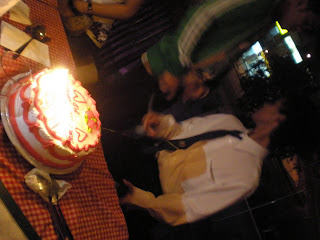Friday, May 30, 2008
Thursday, May 22, 2008
Monday, May 12, 2008
Socio hw.
Name: Firdaus
Group: Be 4
Class: Sociology block 5
Sociology Homework.
1. Distinguish between sex and gender.
- Sex refers to the biological differences between the sexes while gender is the behavioral differences men and women.
2. Describe two sources of evidence that maybe used to sociologist to show that gender differences are socially constructed.
- There is a lot of evidence that can be used by sociologist to show that gender differences are socially constructed. Two of them are, Family and Media. Family is the key agency of primary socialization, it identifies the processes of canalization, manipulation and verbal appellations. From the very first day they are born children are steered into socially accepted gender stereotypes. It is not only dress and toys that produce gender differences but also the interaction between adults and children is structured by gender assumptions. The media in all its forms plays a particular role in gender socialization because it influence crosses the border between primary and secondary socialization. From a very early age, children are exposed to the influence of cartoons and children’s literature. Traditional fairy tales such as beauty and the beast, Cinderella, snow white, little red riding hood, Pocahontas, Jane in tarzan and many more convey latent image of women as the weaker sex and man as the stronger one. Studies of children’s literature and reading schemes show how females are presented in domestic roles. In conclusion, these evidence showed that gender differences are socially constructed.
3. Explain the role of the family in gender socialization.
- Family plays an important role in gender socialization because family is the key in primary socialization. In a family, the parents will always teach the boy how to become a boy and the girl how to become a girl. Parents will treat them differently for example, parents will buy the boy manly toys such as soldiers, car, truck, gun etc. while the girl will get the total opposite for example dolls, ponies etc. even in clothes, parents will buy a blue for the boy and pink for the girl, this is due to perceptions. This factor will help in shaping the gender of that particular someone. The way parents treat a boy and a girl is also different for example, if a boy cries, the parents will ask him to stop crying and be a man, but if a girl cries, the parents will give her a hug. This type of practice will make the boy tougher than the girl, which also contributes to gender socialization. The parents will also encourage the boy to do sports while the girl is encourage to do housework which is a domestic role. Parents do this because it is general and due to again, perceptions.
4. Assess feminist explainations of gender differences.
- They are many explainations from a feminist view about gender differences. This is because there are five types of feminist and they are, liberal feminist, radical feminist, Marxist feminist, black feminism and post-modernism feminism.
The liberal feminist, they argue that the so-called difference between man and women are not innate but the result of socialization and ‘sex-role conditioning’. The different ways that boys and girls are treated from birth discourages women developing their full potential. In this way women are oppressed in society and are seen as subordinate to men. Therefore, to liberate women it is necessary to show that men and women are equal in potential, thus their concern is with fighting for equal fights. In conclusion, they advocates and supports equal rights legislation but failed to explore other explainations for inequalities.
The radical feminist, their basic theory is men are the enemy. They argue that there has always been a sexual division of labour underpinning and reinforcing a system of male domination. Male defined ideas about women’s natural roles and behavior persist in all spheres of society and therefore benefits men and serves to keep women subordinate and inferior to men. Men use their aggression to control women and are thus able to maintain their dominant position. To be free, women need to separate themselves from male domination. In conclusion, they highlight the dark side of the family but failed to account for the different experience of women, particularly in relation and the role of capital.
Next is Marxist feminist, they recognizes both the role of capitalism and patriarchy. Men exercises power over woman and in capitalist societies patriarchy takes a specific form. With industrialization women lost certain legal rights and were excluded from certain spheres of paid work compared to men who gained certain political, legal and economic rights. Women become dependent on males and male needs dominated both within marriage and wider society. Marriage and motherhood became women’s primary role with limited access to paid work. Women serve the needs of capitalism because they are cheap source of labour and reproduce future labour at little cost to capital. In conclusion, they are linked in the role of capital but failed to explore the experiences of men.
Black feminism, they argue that white feminist have ignored the position of black women. Black women have a double disadvantage as they are oppressed by racism in white society and by patriarchy. In conclusion, they highlighted colour blind nature of feminist but ignores similarities between different women’s groups.
Post-modernism feminism, they challenge assumptions around gender identities, they suggested that there are now a range of identities from which women and men can choose from. In conclusion, they highlighted the changes in society however ignores that for some people there is limited choice and the power of gender ideology.
Posted by dose at 9:32 PM 0 comments









